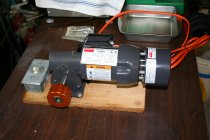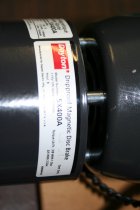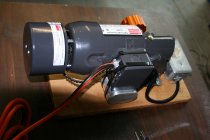You are using an out of date browser. It may not display this or other websites correctly.
You should upgrade or use an alternative browser.
You should upgrade or use an alternative browser.
Neck Turning Speed
- Thread starter skeeljc
- Start date
RegionRat
Gold $$ Contributor
Machining Handbooks show the recommended cutting speeds for materials and alloys in terms of feet per minute at the surface, which can be converted to RPM based on the diameter. There are typical values for properly sharpened High Speed Steel and also Carbide, etc., that can be different.
Here is the catch. Those values are good, but they assume the work piece is held conventionally and when we have a pilot, we have to worry about galling on that pilot. That can mean turning at the recommended cutting speeds with the caveat that your pilot may overheat sooner so the real speed is the limit that your pilot and lubrication can attain.
You will have to adjust your speeds to your own processing within those recommendations and according to the cutter material and dressing (right kerf angles) and lubrication for the pilot.
Here is an example of a table that shows brass. It seems a little higher than what I have in some texts and lower than others, but like I said earlier, these are just guides and not rules of physics.
https://littlemachineshop.com/reference/cuttingspeeds.php
Here is the catch. Those values are good, but they assume the work piece is held conventionally and when we have a pilot, we have to worry about galling on that pilot. That can mean turning at the recommended cutting speeds with the caveat that your pilot may overheat sooner so the real speed is the limit that your pilot and lubrication can attain.
You will have to adjust your speeds to your own processing within those recommendations and according to the cutter material and dressing (right kerf angles) and lubrication for the pilot.
Here is an example of a table that shows brass. It seems a little higher than what I have in some texts and lower than others, but like I said earlier, these are just guides and not rules of physics.
https://littlemachineshop.com/reference/cuttingspeeds.php
I’ve found with a low powered handheld battery drill/screwdriver it really doesn’t matter much as long as you keep the mandrel cool
jepp2
Gold $$ Contributor
I'm certainly not an expert, but I use the max speed on low range on my cordless drill. 450 RPM tends to give the best surface finish.What is a good speed to turn case necks?
Before I started turning necks, many cautioned about heat build up of the turning mandrel and steps to avoid that. Don't know if it is the lube I use (Bootleg) or the 21'st Century expander and turning mandrel diameters, but I have never had that issue. At first I would check it every 5 cases with an IR thermometer and never changed a bit. I've turned over 1K now, many different diameters, same result.
I'm certainly not an expert, but I use the max speed on low range on my cordless drill. 450 RPM tends to give the best surface finish.
Before I started turning necks, many cautioned about heat build up of the turning mandrel and steps to avoid that. Don't know if it is the lube I use (Bootleg) or the 21'st Century expander and turning mandrel diameters, but I have never had that issue. At first I would check it every 5 cases with an IR thermometer and never changed a bit. I've turned over 1K now, many different diameters, same result.
Likewise, I use my variable speed cordless drill with a max 600 RPM and that works well at that speed for me . . . in the Arizona winter when my work area in the garage is pretty cool. My turning mandrel and cutter are carbide in my Sinclair tool (it doesn't generate heat like a steel) and I use no lube as there's no heat issue. When my work area is really warm, like in the summer) I do slow the speed down by about half, otherwise it does heat up some. I like the higher RPM for a nice quick finish.
Like mentioned in a previous post here, the issue is keeping things from heating up so that there's no galling or seizing up onto the mandrel. If properly lubed, one could turn using up to 4000 RPM, or. . . if you just want to be really safe, you can just turn it by hand.
Last edited:
skeeljc asked for some pictures of my wormgear case turner, so here they are along with my experiences. This is the 4th case turner I have had and I have prepped thousands of cases while shooting benchrest and high volume varmint shooting. The turning machines that I bought were all helical gear units, first one from Bruno's a long time ago, the second from Darrell Holland and the third from Don Neilson (Pumpkin). They all use Forster collets to hold the brass. A couple of these were just too noisy for me, and all three had so little internal friction that it was hard to get the collet tight on the case rim. So I decided to put my own unit together and based it on the 175 rpm wormdrive gearmotor in the picture, knowing that the wormdrive would be quieter and have more internal friction to help with chucking. I bought the chuck from Don Neilson and had it fitted to the gearmotor from Grainger. It was quiet and did a great job but still didn't have as much friction as I wanted, so I added the clutch and it is as good as I could hope for now. Hope this helps some of you.
Attachments
Similar threads
- Replies
- 13
- Views
- 1,439
Upgrades & Donations
This Forum's expenses are primarily paid by member contributions. You can upgrade your Forum membership in seconds. Gold and Silver members get unlimited FREE classifieds for one year. Gold members can upload custom avatars.

Click Upgrade Membership Button ABOVE to get Gold or Silver Status.
You can also donate any amount, large or small, with the button below. Include your Forum Name in the PayPal Notes field.
To DONATE by CHECK, or make a recurring donation, CLICK HERE to learn how.

Click Upgrade Membership Button ABOVE to get Gold or Silver Status.
You can also donate any amount, large or small, with the button below. Include your Forum Name in the PayPal Notes field.
To DONATE by CHECK, or make a recurring donation, CLICK HERE to learn how.














